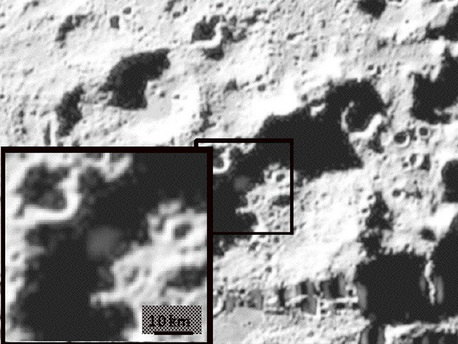LCROSS' Revealing Death
Water Found on Our Moon
 © NASA |
The visible camera image showing the ejecta plume at about 20 seconds after impact.
The impact created by the LCROSS Centaur upper stage rocket created a two-part plume of material from the bottom of the crater. The first part was a high angle plume of vapor and fine dust and the second a lower angle ejecta curtain of heavier material. This material has not seen sunlight in billions of years.
"We're unlocking the mysteries of our nearest neighbor and by extension the solar system. It turns out the moon harbors many secrets, and LCROSS has added a new layer to our understanding," said Michael Wargo, chief lunar scientist at NASA Headquarters.
Scientists have long speculated about the source of vast quantities of hydrogen that have been observed at the lunar poles. The LCROSS findings are shedding new light on the question of water, which could be more widespread and in greater quantity than previously suspected.
Permanently shadowed regions could hold a key to the history and evolution of the solar system, much as an ice core sample taken on Earth reveals ancient data. In addition, water, and other compounds represent potential resources that could sustain future lunar exploration.
The LCROSS team concentrated on data from the satellite's spectrometers, which provide the most definitive information about the presence of water. A spectrometer examines light emitted or absorbed by materials that helps identify their composition.
"We are ecstatic," said Anthony Colaprete, "The concentration and distribution of water and other substances requires further analysis, but it is safe to say Cabeus holds water."
"We were only able to match the spectra from LCROSS data when we inserted the spectra for water," said Colaprete. "No other reasonable combination of other compounds that we tried matched the observations. The possibility of contamination from the Centaur also was ruled out."
Additional confirmation came from an emission in the ultraviolet spectrum that was attributed to hydroxyl, one product from the break-up of water by sunlight. When atoms and molecules are excited, they release energy at specific wavelengths that are detected by the spectrometers. A similar process is used in neon signs. When electrified, a specific gas will produce a distinct color. The ultraviolet visible spectrometer detected hydroxyl signatures just after impact that are consistent with a water vapor cloud in sunlight.
The full understanding of the data will take the scientists some time. LCROSS might have revealed its most spectacular information in the last second before it crashed.
Source: NASA
LCROSS' Revealing Death
Water Found on Our Moon
 © NASA |
The visible camera image showing the ejecta plume at about 20 seconds after impact.
The impact created by the LCROSS Centaur upper stage rocket created a two-part plume of material from the bottom of the crater. The first part was a high angle plume of vapor and fine dust and the second a lower angle ejecta curtain of heavier material. This material has not seen sunlight in billions of years.
"We're unlocking the mysteries of our nearest neighbor and by extension the solar system. It turns out the moon harbors many secrets, and LCROSS has added a new layer to our understanding," said Michael Wargo, chief lunar scientist at NASA Headquarters.
Scientists have long speculated about the source of vast quantities of hydrogen that have been observed at the lunar poles. The LCROSS findings are shedding new light on the question of water, which could be more widespread and in greater quantity than previously suspected.
Permanently shadowed regions could hold a key to the history and evolution of the solar system, much as an ice core sample taken on Earth reveals ancient data. In addition, water, and other compounds represent potential resources that could sustain future lunar exploration.
The LCROSS team concentrated on data from the satellite's spectrometers, which provide the most definitive information about the presence of water. A spectrometer examines light emitted or absorbed by materials that helps identify their composition.
"We are ecstatic," said Anthony Colaprete, "The concentration and distribution of water and other substances requires further analysis, but it is safe to say Cabeus holds water."
"We were only able to match the spectra from LCROSS data when we inserted the spectra for water," said Colaprete. "No other reasonable combination of other compounds that we tried matched the observations. The possibility of contamination from the Centaur also was ruled out."
Additional confirmation came from an emission in the ultraviolet spectrum that was attributed to hydroxyl, one product from the break-up of water by sunlight. When atoms and molecules are excited, they release energy at specific wavelengths that are detected by the spectrometers. A similar process is used in neon signs. When electrified, a specific gas will produce a distinct color. The ultraviolet visible spectrometer detected hydroxyl signatures just after impact that are consistent with a water vapor cloud in sunlight.
The full understanding of the data will take the scientists some time. LCROSS might have revealed its most spectacular information in the last second before it crashed.
Source: NASA





